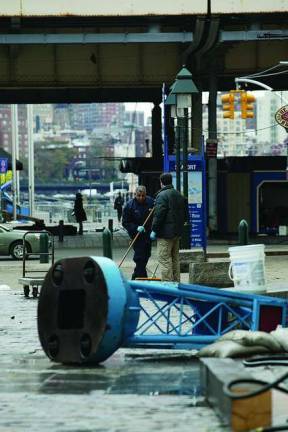Sandy Tears Swath of Destruction through Downtown Manhattan

By Paul Bisceglio Sandy hit New York on Monday evening with the fury promised by ominous forecasts and left behind a wake of devastation wrought by the 80 m.p.w.-plus winds and extensive flooding of lower Manhattan. The grim numbers began to roll in as the post-tropical storm faded on Tuesday: over half a million residents without power, according to ConEd; 1,600 people in shelters; over 80 homes destroyed in an overnight blaze that broke out in Breezy Point, Queens; at least 18 fatalities throughout the five boroughs from fallen trees, fires and rogue power lines. Mayor Michael Bloomberg said that the storm was perhaps "the worst we [the city] have ever experienced." Jeff Masters, director of meteorology at Weather Underground, agreed. "Sandy's 9-foot storm surge rode in on top of a high tide to bring water levels to 13.88 feet at The Battery, smashing the record 11.2-foot water level recorded during the great hurricane of 1821," he wrote in a blog post on Monday evening, reported by the Huffigton Post. "Damage from Superstorm Sandy will likely be in the tens of billions, making the storm one of the five most expensive disasters in U.S. history." Metropolitan Transport Authority Chairman Joseph Lhota said that the damage was certainly the worst that the city's subway system had ever seen. Water flooded seven subway tunnels under the East River and six bus garages, forcing MTA to devise alternate bus routes and to prolong subway closures, which it began preemptively on Sunday, well into the week. "[The system] has never faced a disaster as devastating as what we experienced last night," Lhota declared on Tuesday. The storm forced John F. Kennedy, La Guardia and Newark Airports to shut down, and closed all schools and parks along with many businesses for the week. In the Financial District, the New York Stock Exchange closed for two days, its first multi-day weather-induced closure in over a century. Damages were reported across the city. New York University's Langone Hospital on the Upper East Side lost its backup generator and evacuated 300 patients, many on stretchers down stairs. An explosion at a ConEd substation in the East Village plunged dowtown into darkness. A 150-foot construction crane collapsed 74 stories above ground at 157 W. 57th Street, and as of press time on Thursday, remains dangling precariously over its evacuated neighborhood. The East River overflowed enough to float cars: in the words of an Upper East Side resident, some people "would have been better off with boats." "It's a good reminder that Manhattan's an island," said an NYU undergraduate, referencing Downtown's felled trees, occassional stripped facades and debris-ridden streets. [caption id="attachment_58476" align="alignright" width="300" caption="The Avenue C Squat ran a free cell phone charging station powered by bicycle. Photo by Aaron Adler."](http://nypress.com/wp-content/uploads/2012/11/01_Ways-to-Help.jpg)[/caption] Not all of the city suffered equally, though. Downtown was hit hardest, and stretches along the Hudson and East Rivers require extensive repairs, but many Upper West Side, Upper East Side and Northern Manhattan neighborhoods made it out of the storm relatively unscathed. Shops and restaurants were already opening as the storm died down in these areas, and many residents found themselves either working comfortably at home or with a lot of free time on their hands. "I feel a little guilty," admitted one Harlem resident. "Some people's homes are destroyed, and I have a few trees in my street and a five day weekend." Some began to feel a little stir crazy. "I can only watch so much Netflix!!" posted a friend on Faceboook. Assemblymember Linda Rosenthal told Our Town Downtown that on the Upper West Side, residents were reaching out to afflicted New Yorkers by donating goods and volunteering at local shelters set up for storm victims. "People are eager to help," she said. Micah Kellner, assemblymember in the Upper East Side, said that residents in his district were out and about soon after the storm as well, lending each other a hand and patronizing local restaurants. "Every diner that was open had a line out the door [on Tuesday]," he said. What was "really spectactular," he noted, was the speed of sanitations teams, which he saw out on the streets cleaing up trees as early as noon on Tuesday. Plenty of cleaning still needs to be done. Kellner ? along with Bloomberg and many other elected officials ? has asked New Yorkers, more than anything, to be patient as the city salvages what it can of its damaged neighborhoods and trasportation systems, and begins to rebuild. The return of the usual bright lights and roaming pedestrians in Times Square on Tuesday evening gave little impression that natural disaster had just struck, but powerless Downtown remained a different world after dark. Cars jostled through the streets despite inoperable traffic lights, often ignoring the elected officials' pleas for patiece at free-for-all intersections. Residents ventured out with dogs or friends to become eery figures that appeared suddenly on the dark sidewalks. Police had increased patrols and installed generator-operated streetlights downtown before the storm to prevent crime in the event of power loss, though only so much could be done to reassure people in a section of the city that resembled the Halloween movies they were not watching on their powerless televisions. Still, bus service resumed late on Tuesday, and MTA reopened many subway lines on Thursday. Power creeped back into many homes throughout the week. Stores got back to business, and people went back to work. Progress was clear ? only, in the mayor's words, "this is going to take a while."